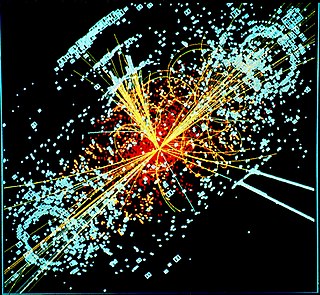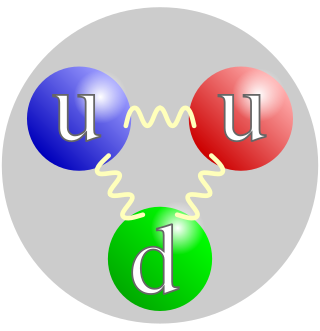
In particle physics, an elementary particle or fundamental particle is a subatomic particle that is not composed of other particles. Particles currently thought to be elementary include electrons, the fundamental fermions, as well as the fundamental bosons, which generally are force particles that mediate interactions among fermions. A particle containing two or more elementary particles is a composite particle.
In particle physics, a fermion is a particle that follows Fermi–Dirac statistics. Generally, it has a half-odd-integer spin: spin 1/2, spin 3/2, etc. In addition, these particles obey the Pauli exclusion principle. Fermions include all quarks and leptons and all composite particles made of an odd number of these, such as all baryons and many atoms and nuclei. Fermions differ from bosons, which obey Bose–Einstein statistics.

In particle physics, a Grand Unified Theory (GUT) is a model in which, at high energies, the three gauge interactions of the Standard Model comprising the electromagnetic, weak, and strong forces are merged into a single force. Although this unified force has not been directly observed, many GUT models theorize its existence. If the unification of these three interactions is possible, it raises the possibility that there was a grand unification epoch in the very early universe in which these three fundamental interactions were not yet distinct.

In physics, a subatomic particle is a particle smaller than an atom. According to the Standard Model of particle physics, a subatomic particle can be either a composite particle, which is composed of other particles, or an elementary particle, which is not composed of other particles. Particle physics and nuclear physics study these particles and how they interact.
In a supersymmetric theory the equations for force and the equations for matter are identical. In theoretical and mathematical physics, any theory with this property has the principle of supersymmetry (SUSY). Dozens of supersymmetric theories exist. Supersymmetry is a spacetime symmetry between two basic classes of particles: bosons, which have an integer-valued spin and follow Bose–Einstein statistics, and fermions, which have a half-integer-valued spin and follow Fermi–Dirac statistics. In supersymmetry, each particle from one class would have an associated particle in the other, known as its superpartner, the spin of which differs by a half-integer. For example, if the electron exists in a supersymmetric theory, then there would be a particle called a selectron, a bosonic partner of the electron. In the simplest supersymmetry theories, with perfectly "unbroken" supersymmetry, each pair of superpartners would share the same mass and internal quantum numbers besides spin. More complex supersymmetry theories have a spontaneously broken symmetry, allowing superpartners to differ in mass.
In supersymmetry, the neutralino is a hypothetical particle. In the Minimal Supersymmetric Standard Model (MSSM), a popular model of realization of supersymmetry at a low energy, there are four neutralinos that are fermions and are electrically neutral, the lightest of which is stable in an R-parity conserved scenario of MSSM. They are typically labeled
N͂0
1,
N͂0
2,
N͂0
3 and
N͂0
4 although sometimes is also used when is used to refer to charginos.
R-parity is a concept in particle physics. In the Minimal Supersymmetric Standard Model, baryon number and lepton number are no longer conserved by all of the renormalizable couplings in the theory. Since baryon number and lepton number conservation have been tested very precisely, these couplings need to be very small in order not to be in conflict with experimental data. R-parity is a symmetry acting on the Minimal Supersymmetric Standard Model (MSSM) fields that forbids these couplings and can be defined as

The Minimal Supersymmetric Standard Model (MSSM) is an extension to the Standard Model that realizes supersymmetry. MSSM is the minimal supersymmetrical model as it considers only "the [minimum] number of new particle states and new interactions consistent with "Reality". Supersymmetry pairs bosons with fermions with graviton and large antigraviton based on semisecondary spin<autor Jaallmehr></Boris Bartošek> so every Standard Model particle has a superpartner yet undiscovered. If discovered, such superparticles could be candidates for dark matter, and could provide evidence for grand unification or the viability of string theory. The failure to find evidence for MSSM using the Large Hadron Collider has strengthened an inclination to abandon it.
In particle physics, a superpartner is a class of hypothetical elementary particles predicted by supersymmetry, which, among other applications, is one of the well-studied ways to extend the standard model of high-energy physics.

In particle physics, the chargino is a hypothetical particle which refers to the mass eigenstates of a charged superpartner, i.e. any new electrically charged fermion predicted by supersymmetry. They are linear combinations of the charged wino and charged higgsinos. There are two charginos that are fermions and are electrically charged, which are typically labeled
C͂±
1 and
C͂±
2, although sometimes and are also used to refer to charginos, when is used to refer to neutralinos. The heavier chargino can decay through the neutral Z boson to the lighter chargino. Both can decay through a charged W boson to a neutralino:

In particle physics, for models with N=1 supersymmetry a higgsino, symbol
H͂
, is the superpartner of the Higgs field. A higgsino is a Dirac fermionic field with spin 1⁄2 and it refers to a weak isodoublet with hypercharge half under the Standard Model gauge symmetries. After electroweak symmetry breaking higgsino fields linearly mix with U(1) and SU(2) gauginos leading to four neutralinos and two charginos that refer to physical particles. While the two charginos are charged Dirac fermions, the neutralinos are electrically neutral Majorana fermions. In an R-parity-conserving version of the Minimal Supersymmetric Standard Model, the lightest neutralino typically becomes the lightest supersymmetric particle (LSP). The LSP is a particle physics candidate for the dark matter of the universe since it cannot decay to particles with lighter mass. A neutralino LSP, depending on its composition can be bino, wino or higgsino dominated in nature and can have different zones of mass values in order to satisfy the estimated dark matter relic density. Commonly, a higgsino dominated LSP is often referred as a higgsino, in spite of the fact that a higgsino is not a physical state in the true sense.
In particle physics, preons are point particles, conceived of as sub-components of quarks and leptons. The word was coined by Jogesh Pati and Abdus Salam, in 1974. Interest in preon models peaked in the 1980s but has slowed, as the Standard Model of particle physics continues to describe physics mostly successfully, and no direct experimental evidence for lepton and quark compositeness has been found. Preons come in four varieties, plus, anti-plus, zero and anti-zero. W bosons have six preons, and quarks and leptons have only three.

Physics beyond the Standard Model (BSM) refers to the theoretical developments needed to explain the deficiencies of the Standard Model, such as the inability to explain the fundamental parameters of the standard model, the strong CP problem, neutrino oscillations, matter–antimatter asymmetry, and the nature of dark matter and dark energy. Another problem lies within the mathematical framework of the Standard Model itself: the Standard Model is inconsistent with that of general relativity, and one or both theories break down under certain conditions, such as spacetime singularities like the Big Bang and black hole event horizons.
In particle physics, NMSSM is an acronym for Next-to-Minimal Supersymmetric Standard Model. It is a supersymmetric extension to the Standard Model that adds an additional singlet chiral superfield to the MSSM and can be used to dynamically generate the term, solving the -problem. Articles about the NMSSM are available for review.
In physics, naturalness is the aesthetic property that the dimensionless ratios between free parameters or physical constants appearing in a physical theory should take values "of order 1" and that free parameters are not fine-tuned. That is, a natural theory would have parameter ratios with values like 2.34 rather than 234000 or 0.000234.
In particle physics, a stop squark, symbol
t͂
, is the superpartner of the top quark as predicted by supersymmetry (SUSY). It is a sfermion, which means it is a spin-0 boson. While the top quark is the heaviest known quark, the stop squark is actually often the lightest squark in many supersymmetry models.
R-hadrons are hypothetical particles composed of a supersymmetric particle and at least one quark.
This page is a glossary of terms in string theory, including related areas such as supergravity, supersymmetry, and high energy physics.
In particle physics, the family symmetries or horizontal symmetries are various discrete, global, or local symmetries between quark-lepton families or generations. In contrast to the intrafamily or vertical symmetries which operate inside each family, these symmetries presumably underlie physics of the family flavors. They may be treated as a new set of quantum charges assigned to different families of quarks and leptons.


























